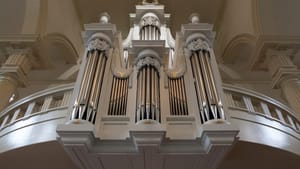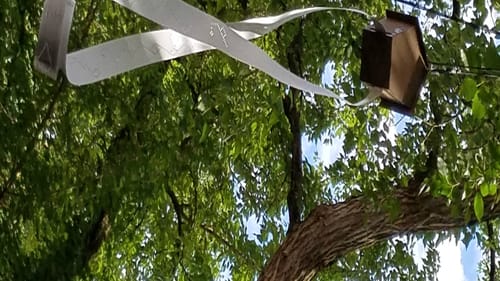Stay in the Loop
BSR publishes on a weekly schedule, with an email newsletter every Wednesday and Thursday morning. There’s no paywall, and subscribing is always free.
When music is breath
Philly Fringe 2018: International Contemporary Ensemble presents ‘In Plain Air’

The Fringe can be fun and cheeky, but it can also be inspiring and contemplative, as it was at the International Contemporary Ensemble’s (ICE) In Plain Air, a program of consciousness-expanding new music at Christ Church. The work also honored the recent installation of the Esther Wideman Memorial Organ, C.B. Fisk Opus 150.
Before the inside program even began, music created by breath and celebrating the connections between instruments and breathing tumbled out of music boxes in the church courtyard, morphed into the cacophonous ringing of centuries-old church bells, and melted back into the church, where a new pipe organ and several dozen instruments advanced the program. In all, the event featured 12 compositions by Phyllis Chen and Nathan Davis, presented without pause over about 70 minutes.
To breathe is to live is to make music
Each of these works in some way reminds us that the air we breathe and the work of our lungs is at the core of musical experience, though this is not as obvious as we may think. Most of us, for example, consider an organ a keyboard, not a wind instrument; but each pipe can trace its lineage to a person playing a simple flute or horn. To breathe is to live. To breathe is to create music.
The program began, almost unnoticeably, in the fern-filled church courtyard, where audience members could wander among music boxes. This work is Chen’s Floating Verses. The boxes, often suspended in the trees, played strips which looked like elongated punch cards from the early years of computer technology. These strips were created by some 150 community members during a workshop in July. The sound was warm, inviting, and friendly, and though each of the 10 or so boxes was doing its own thing, they still meshed in an overall impression of harmony. There’s a lesson here about thriving as unique individuals while building strong communities. A solo box hand-cranked by Chen carried the program to its second work, Chen’s Rapunzel.

Wild bells and pulses
Almost imperceptibly, the focus rose to the sound of church bells in the carillon, Davis’s Bellarmonic. I wondered what the neighbors thought of this uncharacteristic explosion of church bells pealing far and wide. “Ring out, wild bells, to the wild sky,” as Tennyson wrote. Davis and colleagues were able to bypass the carillon mechanism to extend the tones beyond the normal length created by a clapper. In the printed program, Davis commented that “the audience can have the rare and extraordinary experience of hearing these wonderful and historic instruments as they actually sound in the belfry.”
As the audience moved inside the church, the program focused on new approaches to traditional instruments. Chen’s work, Pulses, was inspired by the ancient Chinese medical technique of taking pulses, which is much more complex and yields more information than the traditional Western method. This complexity of pulses is expressed through the rhythmic variety of organ playing and in consort with the French horn (a remarkable performance by Chen and hornist Nicolee Kuester).
Again, the theme of “plain air” was reaffirmed: pulses, breathing, pipes, horn. During her performance, Chen emphasized some of the lowest notes of the organ, which vibrate so profoundly that they create their own harmonies. Like Beethoven in his piano sonatas, Chen uses brief patches of silence which, at the same time, have the effects of shocking and bringing us back to reality.
‘Inside Voices’
For Davis’s Inside Voices, the other members of the ensemble were spaced along pews, for the most part, at the balcony level. Individual voices of dulcimer, guitar, bass saxophone, and other instruments, including electronics, initially appeared singly, often producing breathy sounds on their instruments. As the piece developed, there was more overlap and the breathing sounds evolved into a richer tone, moving eventually to a massive block of sound. The conventional idea of “melody” yielded to a focus on rhythmic interest and creative exploration of sonority.

Davis said he was inspired in this work by seeing and hearing the new Fisk organ during its installation, but before all the pieces were in place. In his words, “the members of ICE, using their instruments to produce air sounds, form a metaphoric human bellows that is played using virtual valves created electronically.”
Sounds of innovation
Given the serious nature of the program, I particularly enjoyed a light diversion (that’s my interpretation, not necessarily the composer’s) of a half-dozen melodicas in Davis’s Pistons & Divisions. These are mini-keyboards with oboe-like mouthpieces held like recorders. The program notes didn’t tell us much about this work except that it is for harmonium and organ, but it was refreshing and bright.
Each of the other six works on the program were imaginative, performed by musicians with consummate mastery of their instruments, and interpenetrated by a sense of respect and regard for history, place, and community. I can’t wait to hear another program by this engagingly innovative ensemble.
What, When, Where
In Plain Air. Composed by Phyllis Chen and Nathan Davis. International Contemporary Ensemble and Christ Church Preservation Trust. Through September 23, 2018 at Christ Church, 20 N. American Street, Philadelphia. (215) 413-1318 or fringearts.com.
Sign up for our newsletter
All of the week's new articles, all in one place. Sign up for the free weekly BSR newsletters, and don't miss a conversation.

 Linda Holt
Linda Holt